First Exercises After Gene Therapy

Gene therapy is complete! Now what? The first day after receiving the monumental gift of our daughter partaking in a clinical trial for gene therapy, we asked ourselves this exact question. There were no handbooks on what to do after this revolutionary procedure.
We began working with a physical therapist to guide us. Aromatic l-amino acid decarboxylase (AADC) deficiency is often confused with other disorders, so it made sense that we could adapt the physical therapy exercises from those same ailments. We learned strategies and techniques we could effortlessly implement at home.
Developing strong core muscles is the foundation that leads to sitting, crawling, and eventually walking. Below is a list of core exercises that made a difference for our daughter, Rylae-Ann, after gene therapy. However, these would be great exercises to do before gene therapy, as well.
The key to increasing motivation and maximizing learning was incorporating play-based learning while performing these exercises.
Tummy time
Before we even knew anything was wrong, we noticed Rylae-Ann could not do tummy time and would lie facedown, unmoving but screaming. We searched symptoms online, but she could not make any progress before gene therapy. We would try to space tummy time activities throughout the day, starting for a short time and slowly increasing the time.

Over time and with the aid of a burpee and motivational toys, Rylae-Ann enjoyed tummy time and became stronger. (Photo by Richard E. Poulin III)
After gene therapy, Rylae-Ann began to progress, but the process did not start as a welcoming experience. It would take several months until she was a willing participant on her belly and could begin to lift her head. We used a burpee pillow to cushion her position and make it easier to move her neck muscles. To encourage her to stay in this position, we motivated her with toys and songs.
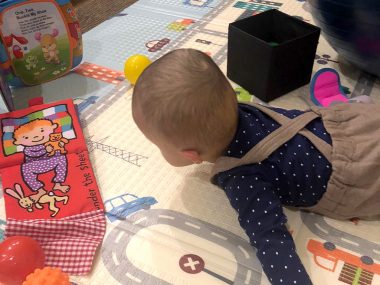
Tummy time was an opportunity for learning and exploring. (Photo by Richard E. Poulin III)
Touching toes
This toe-touching exercise also encouraged Rylae-Ann to reach out and grab toys. We helped her to use her hands to grab her toes. At the same time, we could stretch her core and back muscles.
We would do this exercise in various ways. She used the same hand to grab the same side toe and then switched, so she crossed her midline by grabbing her opposite toe. Putting stickers on her toes was a fun way to encourage her. Soon, she was doing this on her own.
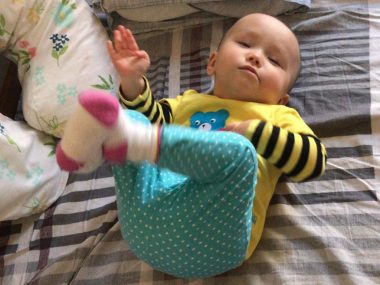
Once Rylae-Ann developed the muscles, she would reach out and grab her toes on her own. (Photo by Richard E. Poulin III)
Rolling
The feeling of rolling can be a drastic sensation for our children post-gene therapy. The first step is to allow them to alternate lying on their sides. You can use toys to keep their attention. When you have their attention, slowly move the book so that they turn with it and return to their back. Later, add to this by continuing the movement, so they roll and lie on their opposite side. They will be able to do a full roll once they are comfortable with tummy time.
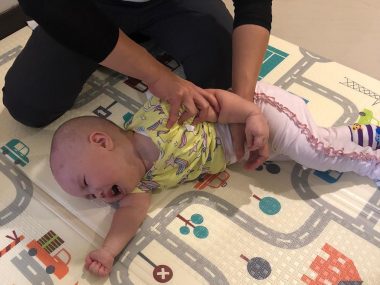
Even the simple act of rolling to the side was scary for Rylae-Ann at first, but over time she adjusted and made progress. (Photo by Richard E. Poulin III)
Play and roll with them slowly so they become familiar with the movement that I assume must feel like an amusement ride from their perspective. As you gradually roll your child like bread dough, encourage them to use their muscles throughout the movement. Over time, apply less support and allow them to take more control during the roll.

Surrounding Rylae-Ann with her favorite toys, she learned to roll to her sides. (Photo by Richard E. Poulin III)
Yoga ball
One of the first actual pieces of physical therapy equipment we bought was a yoga ball. When bringing this ball out, Rylae-Ann’s eyes would enlarge, and she would release a banshee scream. With anxiety already high, she knew this ball meant work was coming.

Rylae-Ann did not enjoy the yoga ball exercises for a long time, but we continued to push her, and the results were worth it. (Photo by Richard E. Poulin III)
We had several exercises to do on this ball. It provided a surface that made Rylae-Ann more aware of her movements and balance. Performing core exercises on this ball took a long time before she would giggle.
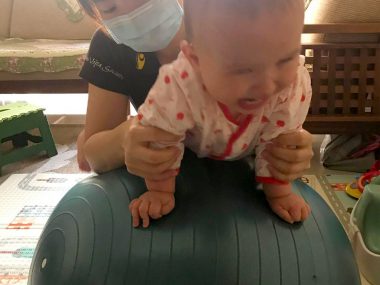
Not only was the yoga ball scary for Rylae-Ann, but it was also very challenging. (Photo by Richard E. Poulin III)
Hands and knees
While learning to crawl, Rylae-Ann was able to do strengthening movements and increase coordination. I remember how tedious this was, but we did this exercise at the start and end of each day.
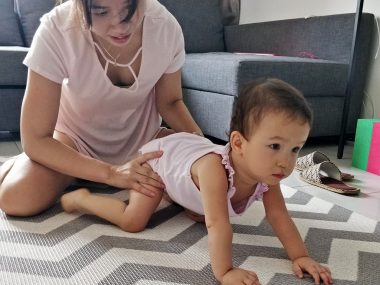
Mom helps Rylae-Ann perform a stationary crawling position to develop muscles that will support crawling independently. (Photo by Richard E. Poulin III)
Working with my wife, Judy, we would coordinate crawling movements while supporting her limbs to stay strong. There would be pauses where Rylae-Ann would have to remain stationary. Over time, we very slowly reduced the amount of support.
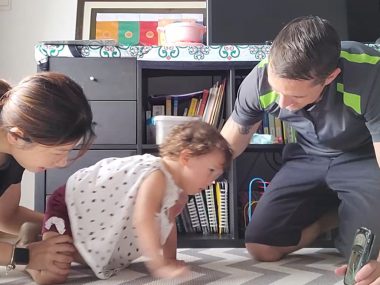
Rylae-Ann’s parents work as a team to support her developing core, arm, and leg muscles. (Photo by Richard E. Poulin III)
Sitting and tilting
After eating, your child must remain upright to prevent aspiration since they are still building muscles post-gene therapy. This time offers an excellent opportunity to perform sitting exercises for at least 30 minutes.
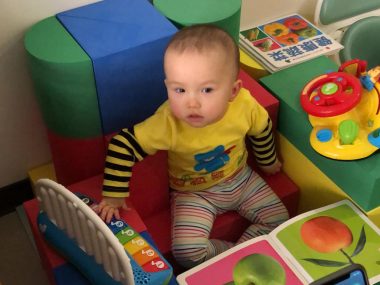
We created what we called a sitting command center that allowed Rylae-Ann to assume a sitting posture with motivating toys around her to encourage weight shifting and core-muscle work. (Photo by Richard E. Poulin III)
Have your child sit on the floor with their back to your chest and help them keep proper posture. You can reach around and place fingers on their belly or lower back to encourage them to engage their muscles. Over time, slowly scoot back and move the support to being only your hands until they are sitting upright by themselves. Add in some tilting action so they learn to correct themselves and restabilize their sitting position.

When Rylae-Ann sits on the ground or on a block, we use our body to support her, slowly reducing that support. (Photo by Richard E. Poulin III)
Another way to perform sitting exercises is to have them sit perpendicular to your body while on your leg. Their feet should be planted on the ground between your legs. Use the hand next to their back to keep them from falling back. You then use the other hand to encourage them to stand.
Your legs pushed together will keep their feet on the floor and act as a scaffold. It is conducive if someone is standing and encouraging them to stand with a toy.
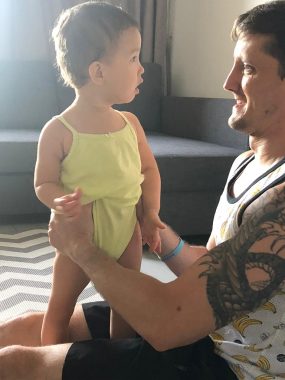
Rylae-Ann works with Richard, at right, beginning to feel the independence of standing by performing side-saddle sit-to-stand exercises. (Photo by Richard E. Poulin III)
Sitting on a block or stool with no back is another excellent exercise. Make sure it is at a height where their feet can rest firmly on the floor in a sitting position. Sitting behind them, you act as support and can also encourage them to stand from this position. Over time, these will be practiced in conjunction with standing exercises.
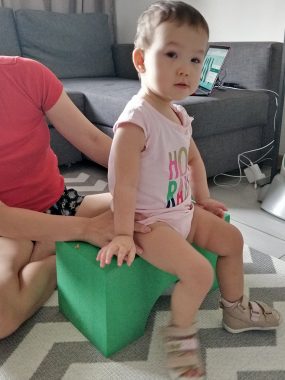
Using a block, Rylae-Ann’s mom supports her so she can learn to sit independently and build her core muscles. (Photo by Richard E. Poulin III)
Note: AADC News is strictly a news and information website about the disease. It does not provide medical advice, diagnosis, or treatment. This content is not intended to be a substitute for professional medical advice, diagnosis, or treatment. Always seek the advice of your physician or other qualified health provider with any questions you may have regarding a medical condition. Never disregard professional medical advice or delay in seeking it because of something you have read on this website. The opinions expressed in this column are not those of AADC News or its parent company, Bionews, and are intended to spark discussion about issues pertaining to aromatic l-amino acid decarboxylase deficiency.







Leave a comment
Fill in the required fields to post. Your email address will not be published.